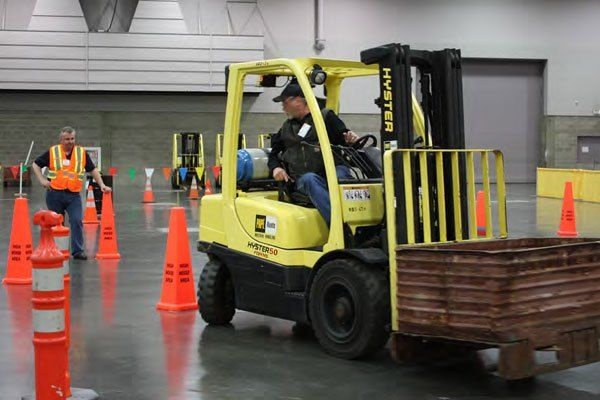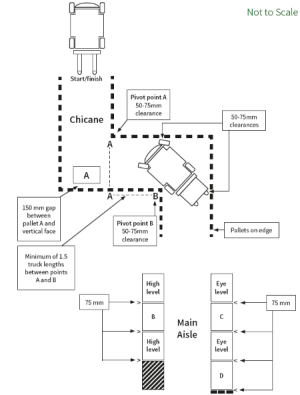Forklift operator practical test
The largest forklift operator training website in the world
Practical test course dimensions

The forklift operator practical test course has been designed so that it can be made of naturally occurring materials such as pallets, loads, stacks, racking and other permanent constructions, subject to critical dimensions being maintained.
There are, in fact, two test courses and the alternative one is shown .here
All loads handled by the lift truck during the test should be of identical width, height, length and weight.
The chicane should consist of one left and one right angle turn which can be in either sequence. Traditionally this is constructed using pallets but other materials may be used providing there are no gaps that the forklift/load can fit into.
The distance from the chicane to the test aisle is not critical but there should be sufficient distance so that the candidate can reverse out and position the forklift truck ready to enter the aisleway again for the next operation. The chicane dimensions are important and there should be between 50 and 75 mm clearance between the forklift truck, load and the chicane at all critical points as shown on the plan.
The width of the main aisle should be the forklift manufacturer’s minimum 90 degree stacking aisle width for that particular truck and any load overhang, (i.e. from the tips of the forks to the front leading edge of the load), plus 300 mm, (12 ins), for counterbalanced trucks and 200 mm, (8 ins), for reach trucks. The theoretical minimum 90 degree stacking aisle width may be obtained from the forklift truck manufacturer.
Loads along the main aisle should be stacked in line with 75 mm, (3 ins), spacing between the loads or the racking uprights where applicable.
The space at ‘D’ where the low level stack is placed, should allow for the width of load with 75 mm, (3 ins), spacing on either side. (Shown on the plan).
The starting/finishing load shown on the plan at A should be no more than 150 mm, (6 ins), from the vertical face and not touching it. This load should be high enough to obscure candidate’s vision, thus requiring them to make blind judgments of positioning while negotiating the chicane during stacking and de stacking operations in the main aisle, and when depositing the load at the vertical face.
Stacking heightsHigh Level at ‘B’ refers to the maximum stacking height normally to be found in the candidate’s working environment for the particular lift truck and loads in use on the test. High level is a minimum of 3 m, (9 ft 9 ins), stacking height. In situations where the maximum stacking height is less than 3 m the certificate must clearly show the maximum stacking height used in test.
Eye Level at ‘C’ Refers to the stacking position which requires the forks to be inserted at a height corresponding to the level of the candidate’s eyes when in the normal operating position on the lift truck.
Low Level at ‘D’ Refers to the stacking position at, or there about, ground level.